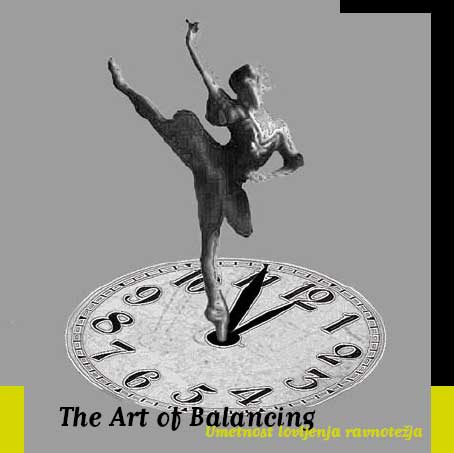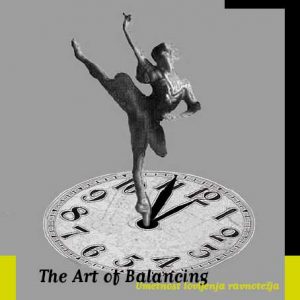[Original at http://www.3via.org/records/index.php?opt=item&id=3]
Borut Savski – Art of Balancing
Basics:
Title: The Art of Balancing/ Umetnost lovljenja ravnotežja
Author: Borut Savski
Year: 2006 / 2007
Format: printed as a cd or dvd booklet
Language: English and Slovene
Remark: This booklet is not sold or sent separately – it can be a part of any of the author’s cd’s or dvd’s.
Borut Savski – The Art of Balancing
The photomontage on the cover is an attempt to artistically convey my idea of human self-regulation (self-balancing) which links the idea of »the whole« (perfection, God etc.) to the human concept of time. Thus I address the long separated concepts of reflection, motivation and motion as a unified whole.
A figure of a ballet dancer standing on toes of one foot is an archetypal symbol of humans aspiring to perfection (»moving, looking upwards«), which was transformed into a ballet technique of dancing on toes in the »classical« bourgeois art of the 19th century. It was during that time »that the aspiration to God« was being increasingly replaced by the »aspiration to perfection« in all areas of creativity.
Dancer
I see the above-mentioned classical ballet ideal as the »art of balancing«. In one of my projects I used the principle of the gyroscope to create a mechanical moving object that I called Dancer. The gyroscope is a fast-rotating mass which produces a force called precession. This force keeps the rotating mass in its existing balanced position – it resists any force which would change the gyroscope’s position. Resistance to changes in the system’s existing state is called inertia and is a property of any physical body with mass. No event in the material world can change its existing state in zero time. Inertias are in fact some sort of identities of any system. Combined complex systems are complex combinations of the inertias involved. Inertias are functions of time. They describe how a system behaves in time.
Mind Objects, Structures, Bodies
What about non-material objects? For example: ideas, concepts, thoughts, dreams? The most important human property is the non-material – the human psyche, the human spirit. When we think about such entities, we see them as objects, things, bodies. These are objects because they also try to resist the outer force – they show inertia. For example: our ideas fight against
the convictions coming from outside – but if we don’t have a concrete thought yet, we usually just take an idea from the outside.
In the photomontage on the cover, the concept of absolute linear time, the symbol of which is the clock, is combined with another basic symbol: the circle, which is the symbol of perfection (the whole). Both represent the highest level of abstraction. The human spirit can often reach out and touch them, but not always and not completely: the absolute is always just a step away; there is always just 5 minutes to perfect fulfilment. Another name for perfection used to be God: »GOD is the beginning and the end«.
< O >
Another time-related (or unrelated – i.e. constant) property (inertia, a time function) that emerges from time (the timeline) is – subjectivity. Subjectivity is an individual’s psychological projection back and forth onto the timeline. With subjectivity, we draw a picture of ourselves in time. The human being does not exist outside of time – the animal is outside of time, and that is why the animal is perfect. Time brings in imperfection, unfulfilment, indeterminacy, inconclusiveness – but also infinity; desire on the one hand, and (again) God on the other.
Motion, Motorics and Motivation
The Dancer was one of my conceptualizations of an autonomous moving object. It functioned on the principle of moving through a sound field turning left or right depending on the differences in the sound pressure. Thus its communication channel/code (its higher meaning, its motive) was sound. The sound as a motive is already an abstraction (a human translation).
The primary motive was motion, while the secondary motive (the derived one, the abstracted one) was transformation into sound Somewhere in-between there was a moment of translation, of alienation: a change in the evaluation system. Attention shifted to sound – but then the basic understanding of the technology was gone. As we forget the primary causes, a space opens for new understanding, for new ways of thinking. A potential for mystification, fascination? Since the sound was linked to the movement, this change was not drastic, however, it allowed the object to achieve some »artistic purpose« – an aesthetic action. So: mystification, fascination – a potential for art?
Myth = Meat (Body)
The above logic is similar to the way in which myths are constructed. A myth is an (imaginary) object, concept that becomes self-contained (and credible, real) when it loses its previous causal relations that define its structure. A myth does not provide any tools for understanding – it is »felt« directly – it touches us emotionally, not rationally. We no longer know what the reasons that »constructed« the myth were. If we did, the myth would dissolve – it would lose its body. This is called demystificaton. Demystificaton helps us observe the relations that are hidden behind the »seven veils« – it helps us understand the relations and hopefully – know the truth. Art always deals with myths – either with their deconstruction (with the truth, the philosophy behind them), or with the stories that myths tell us (with the fiction, the emotional potential in them).
Deconstruction of Myth = Demystification
Myths are complex »bodies of meaning« – mind structures/systems – a kind of »translators«. They do not bring understanding and they cannot be easily dismantled. Humans are able to think only in terms of ready-made structures, bodies –in patterns. All mind bodies are complex combinations/relations of questions formed into something very handy, so that we can easily carry them with us and use them at any moment. But of course, in this way we cannot carry with us the understanding itself. In order to achieve understanding, we must decompose, deconstruct such a body (the myth) each time, and every time the results will be
different.
In their simplest form myths are stories that are constructed as archetypal relations. These stories are practically timeless – they are the roots of culture (and of our patterns of public behaviour). They are symbols, stereotypes. They are the basis of our »collective mind«. We almost never doubt them – so they are a good cohesive cultural force – we all agree on them. On a linguistic level they often represent very interesting linguistic equations. In mathematics, these would be paradoxes, but within language they seem like »the final truths«: »a woman is a woman«, »a man is a man«. These linguistic equations – when spoken as statements – establish complete agreement since they do not tell anything new. They have nothing to do with the explanation or interpretation of meaning – this comes later on, if ever. Such statements are very useful for the so-called hate speech.
Aestheticisation = Mystification
Since my information channel (»the aesthetic dimension«) is almost always the sound – and the sound is the element that constitutes the music – let’s jump to music. It is very hard for a piece of music to go beyond the boundaries of what makes music music; even most experimental works keep the mimetic elements: a storyline, an emotional potential, a superficial glow, some kind of tonal properties, rhythmic elements etc. I call this »aesthetisation«, and I consider it a negative attribute. By aestheticisation I mean that unnecessary elements have been added for the sake of »telling a story« that can totally obscure the basic purpose of the artistic search into the unknown – i.e. the experiment.
Aestheticisation is linked with superficiality (with sensation, even emotion) – it is a kind of »instant knowledge« (»I see«; »I feel good«, I sense danger«), which is a very basic form of nonverbal understanding. The way we understand myths is also a kind of »instant knowledge«.
Dionysiac and Apollonian
Here I point to another “classic” confrontation – that between the dionysiac and the apollonian – the confrontation between body and mind. In »artistic terms« I would describe it as a predominance of »skin« over »bones«: surface versus structure; Myth versus Meaning. One might think that there is meat under the skin, but the language tells us that it is the bones. The meat has a strong sexual connotation, and given today’s prevalence of pornography, it would be useless to ascribe »substance« to »meat«. So: the meat is part of the skin in the same manner as the emotion is part of the body (even if the emotion is non-material and the body is material). And: the bone is the structure – the substance (of the body).
Myth versus Meaning
Art (again understood as a derivation – a higher level of abstraction – of human ability to perceive and reconstruct reality – mainly for reasons of communication) has roots in both: the ritualistic approaches concerned with body (and emotional) transformations and the (more) transcendental approaches concerned with spiritual transformations. The former has to do
with perceiving, feeling, knowing and the latter with understanding (but also with knowing). Both methods give an answer, however, the first one is much quicker (almost instant), while the second one takes more time, but it can provide a variety of results.
However, if one chooses to explore, to experiment, to gain knowledge, it is only the second method that produces new results. Individualisation (a departure from the common/collective roots) comes only from the second – cognitive method. In experimental art, that is the only viable method because it presents the new – or a new view of inner/inter-relations. Or better
yet: it uncovers the truth.
Fifth Dimension & Production of Reality
When we internalise something as a memory, we make a body structure out of it. It is a simple evaluation system – some sort of »philosopher’s stone« (»that can turn stone into gold«). The alchemists were of course searching for Truth and we could observe the philosopher’s stone as our point of translation, transformation, abstraction, alienation. It is clearly not possible for a human to visualise anything more complex than a 3-dimensional dynamic object. This is usually referred to as the 4-dimensional space. We overcome this problem by abstracting reality into pattern structures (like in statistics) we can observe while the system is changing. Thus everything becomes very abstract – original correlations are lost – new objects, new words, new meanings emerge. This is the fifth dimension – it is what we call the representation of reality. It actually throws us one dimension back – so that we can »see« again.
A very similar explanation could be used when observing the various degrees of a juggler’s skill. A juggler with one ball is not a juggler at all, and almost anybody can learn how to juggle with two balls. It is with three balls that juggling becomes hard – with one ball always in midair. I believe that three balls represent the ultimate skill – more balls are just a version of the »third ball in the midair«.
Fascination = Mystification = Magic
The fascination of the observer starts with the introduction of the third ball. That is the point where it becomes “magical”. Our eyes (-> our brain) can no longer follow the “logic” (-> the technology) of the action, so we shift our attention to observing the pattern (a new “object” or “body” or “abstraction” as described above). A translation process between the old and the new understanding is that of fascination – or any other kind of alienation effect (e.g. the passing of time). This process has to do with the socalled production of reality and it is not valid for language only (a production of symbolic bodies), but also for any other kind of structured concepts, objects, bodies.
Borut Savski


